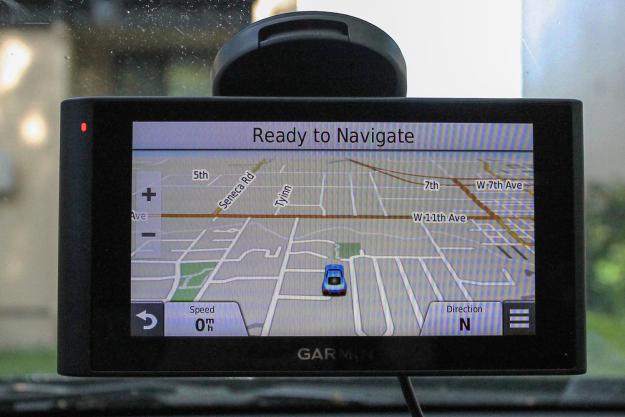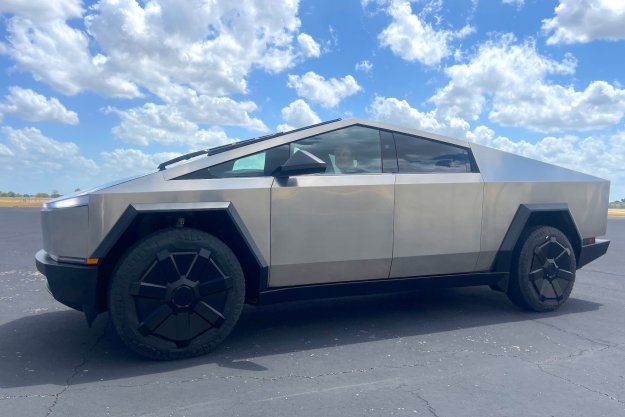
“The NuviCam doesn’t just watch the road; it watches your back with a dash cam, GPS, and driver assist functionali-ty.”
- Simple, accurate navigation on high-resolution screen
- Easy-to-use voice commands
- Driver-assist features are a nice addition
- HD dash cam never stops recording
- Driver assist safety functions are costly
The Garmin NuviCam plopped onto my windshield with a satisfying clunk. The unit felt sturdy and secure as I attached the suction cup to the glass, and the 6-inch screen’s magnetic mount emphasized its impressive build quality.
Garmin’s newest product, a part of the brand’s Prestige Series, combines dash cams, GPS navigation, and driver assist functions into one, making it a sort of digital Swiss Army Knife for your car.
The Garmin NuviCam is an ambitious product that does everything it sets out to do, and does it well.
At its core, the NuviCam is a solid navigation unit with a bunch of extras tacked on. Its HD dash cam is always recording, and it saves footage automatically in the event of an accident. When traveling over 30 mph, the device’s camera can sense if you’re following too close to the vehicle in front of you, and it uses visual and audible warnings to get you to back off. If you exceed 40 mph, the NuviCam recognizes when you’re drifting out of lane. It can do it all.
Buy it now from:
It’s a new flavor of GPS unit — one that offers driver-assist safety technologies that are “typically found only in luxury vehicles,” the company says.
After calibrating the camera and scrolling through a couple disclaimer screens, I was ready to see how this thing performed on the road.
Getting there
The Garmin name is most closely associated with navigation, so the NuviCam could not afford to coast in that regard. Luckily, it does not. After fiddling with all the included functions, I found the GPS to work near perfectly.
Addresses can be typed in manually or dictated via voice command, which recognizes phrases like ‘view map,’ ‘find place,’ ‘find category,’ ‘recently found,’ and ‘find intersection.’ We’ve all struggled with subpar voice controls before (I said “go home” not “phone Joan”), but thankfully, this isn’t one of them. When I resisted the urge to mumble, the NuviCam understood my words every time.
Once you’re on the road, the glass screen’s high-resolution, pinch-to-zoom display works quickly and accurately. Garmin’s ‘points of interest’ feature is a standout here, as it lists nearby restaurants, gas stations, shopping centers and the like with handy pull out menus.
If you’re traversing an unfamiliar area, Garmin’s ‘Real Directions’ really comes in handy. Using local landmarks and traffic lights as reference points, the feature will guide you with phrases like, “In 500 feet, use either of the two right lanes and turn right at the stoplight” instead of simply, “Turn right in 500 feet.”
On the screen, a rendering of the area pops up, with a highlighted purple arrow illuminating the correct route and highway exit sign if applicable. This technology works great in busy metropolitan areas especially, amplifying your sense of direction and overall awareness drastically. There is one downside, though: If you miss your exit, there’s no one to blame but yourself.
Once you arrive at your destination, ‘Garmin Real Vision’ kicks in. It enlists the dash cam to display a real image of your surroundings, then overlays an animated arrow that points to the exact location you’ve entered. I found this especially useful when navigating blocks of lookalike apartments or stacked shops.
A watchful eye
Garmin’s high-def dash cam is always recording when the device is on, providing a clear, unbiased visual account of accidents, alien abductions, or whatever else you feel like capturing. There’s even a still shot feature, which could help with the documentation of vehicle damage. It also allows you to keep your phone in your pocket if you happen upon a cant-miss photo opportunity.
Because the NuviCam has an integrated G-sensor, it senses if you’re involved in a collision and automatically saves the video to its 4GB MicroSD card. 4GB is probably sufficient for those who just want footage of accidents and whatnot, but if you want to archive substantial driving film, you may want to consider upgrading.
Driver Assist
Let’s move on to the driver-assist safety features of the NuviCam, as these functions are really what set it apart from the pack.
‘Forward Collision Warning’ is the most dramatic sounding of the two, but it’s hopefully the one Garmin owners will use the least. When traveling more than 30 mph, the unit’s GPS and camera work together to determine safe following distance between you and the car ahead. If that distance is violated, a red bar appears on the top of the screen and a distinct acoustic warning sounds.
It’s always nice to have an extra pair of eyes watching out for you.
Practically, I found this feature to act more like a tailgating sensor than anything, but it’s always nice to have an extra pair of eyes watching out for you.
Because it’s a camera-based system, Garmin’s ’Lane Departure Warning’ works very similarly to the functions found on mainstream automobiles. If calibrated correctly, the camera reads solid lane markers on either side of the street well. The sharp tones can get tiresome to listen to, but no more so than with the features found on luxury cars. That, in itself, is a success.
Conclusion
The DT Accessory Pack
Up your game and the get the most out of your gear with the following extras, hand-picked by our editors:
Garmin Wireless Backup Camera ($170)
Garmin’s NuviCam LMTHD is backup camera accessible, but the product is sold separately. The BC 30 allows you to monitor behind as well as in front.
SanDisk Ultra 32GB microSD card ($15)
Increase your video and picture storage with this 32GB MicroSD card.
AAA 66-Piece Road Kit ($43)
To help keep you safe during a breakdown, this roadside assistance kit features warm fleece gloves, emergency candles, a folding shovel, an ice scraper, a whistle, and first aid supplies.
In the end, the Garmin NuviCam is an ambitious product that does everything it sets out to do, and does it quite well. It could also turn out to be a huge trendsetter for dash-mounted devices.
At $400, though, there is one big question: Are the extra features worth the money?
The Magellan RoadMate 6230-LM Dashcam Navigator offers many of the functions of the NuviCam (GPS, HD dash cam, free lifetime map updates, landmark guidance, a G-sensor, points of interest, etc) at half the price.
To be fair, the Magellan has a 5-inch screen and does not include Bluetooth calling, voice commands, Foursquare, or driver assistance features, but the cost gap is significant. Are the extras worth the coin? Well, that depends on your priorities, but that’s a question you’ll have to answer for yourself. For us, the Garmin NuviCam sets a new standard for dash-mounted accessories.
Highs
- Simple, accurate navigation on high-resolution screen
- Easy-to-use voice commands
- Driver-assist features are a nice addition
- HD dash cam never stops recording
Lows
- Driver assist safety functions are costly





